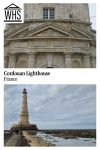Cordouan Lighthouse
By Rachel Heller
What is Cordouan Lighthouse?
Completed in 1611, Cordouan Lighthouse has lit the way ever since then for sailors approaching the Garonne Estuary north of the city of Bordeaux in France. Initially 37 meters tall (121 feet), it was built on a tiny island at the behest of Henry III, king of France. But his intention was not just to improve safety at sea for the many ships carrying goods into and out of Bordeaux. It was also to make a statement of power and prestige: to build a lighthouse that would withstand the ages, much like ancient Egypt’s Lighthouse of Alexandria.
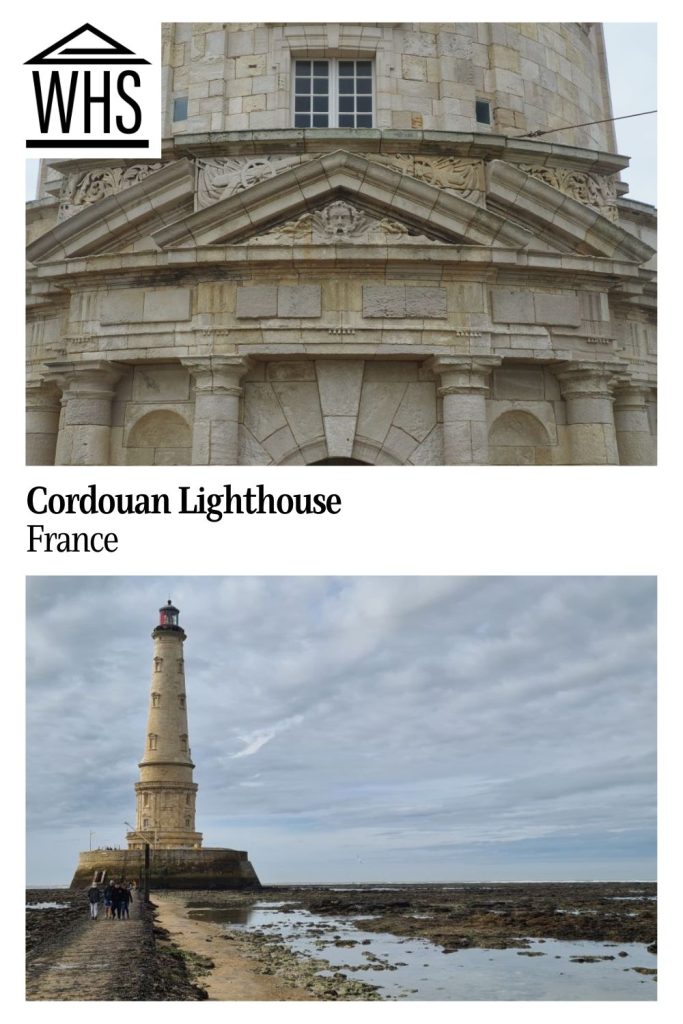
For this reason, the lighthouse isn’t just a utilitarian structure. It is adorned with statuary, both inside and outside, that refers to the Italy of ancient Rome and the Renaissance at the same time. For example, the level of the lighthouse called the “king’s apartment” (though no king ever visited), includes marble-tiled floors and Ionic columns. The floor above that, the “royal chapel,” is similarly ornate. These two floors, by the way, were decorated under Henry IV’s orders. The lighthouse was “intended to impress all the European sea powers and local communities,” according to UNESCO.
Disclosure: This article contains affiliate links. Making a purchase through an affiliate link will mean a small commission for this website. This will not affect your price. Privacy policy.
In the 18th century, because the beacon did not reach far enough, the lighthouse was extended, reaching a total of 67.5 meters (221 feet). The addition did not detract from the design at all, matching it so that if you didn’t know, you’d think it was originally that way.
While the methods of lighting have changed over time, the lighthouse functions pretty much as it always did, and to this day there are two lighthouse keepers living in the quarters at its base at all times.
Why is Cordouan Lighthouse a UNESCO World Heritage site?
To quote the UNESCO listing, “Cordouan Lighthouse, in its intentional monumentality, is a grandiose and unique creation, in which the human genius is not only architectural, stylistic and technical, but also symbolic and conceptual.” It is a UNESCO site because it is an example of human ingenuity both in the technical aspects of maritime signalling, but also in how it glorifies the king. The fact that it continues to serve its function after centuries in an extremely hostile environment contributes to its importance as well.
At the same time, the extension added in the 18th century is a “superb integration,” which demonstrates the progress that had been made by that time in terms of the technology involved.
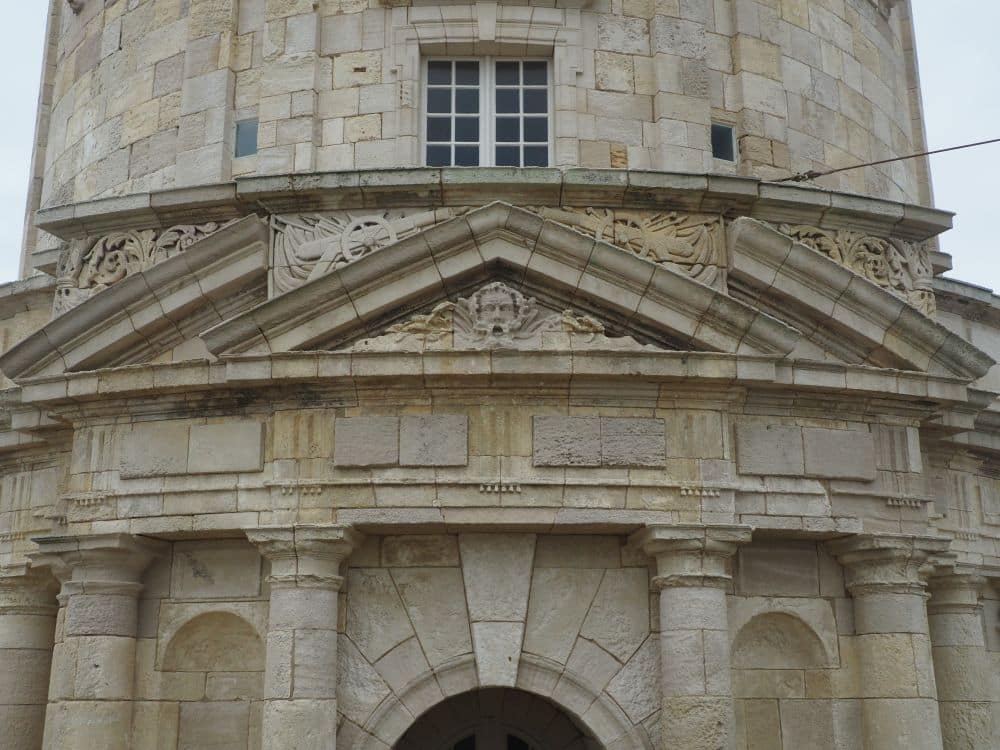
What can you expect on a visit to the lighthouse?
Cordouan Lighthouse is not easy to get to. You have to take a tour from one of two companies, leaving from either Verdon-sur-Mer or Royan. Otherwise, you can visit in your own boat – but given the hazards of running aground, that doesn’t seem advisable.
Getting there
We took the tour from the port of Royan. Leaving at about 10 in the morning on a gray day, the trip took about 45 minutes. The small ship held perhaps 50 people, though its capacity is much higher, and there wasn’t much to do but hang on – the sea was a bit rough – and watch the scenery, looking for the lighthouse to appear in the distance.
However, the boat didn’t actually take us to the lighthouse. Some distance away, we stopped dead in the water, and a smaller boat, which we’d been pulling behind us, came up alongside. This smaller boat turned out to be an amphibious vehicle with large wheels underneath, though I didn’t know that at the time.
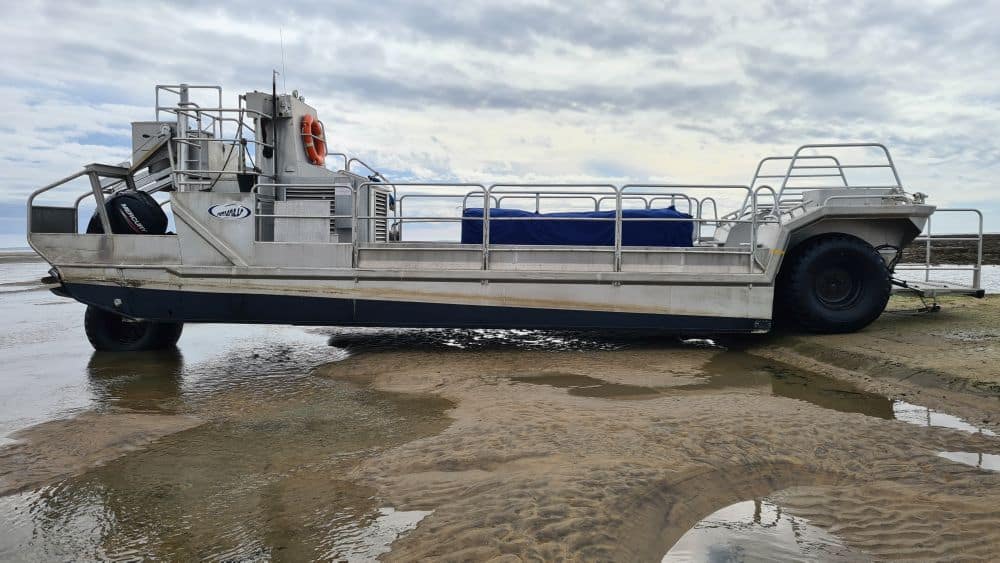
We crammed onto the smaller boat until about 30 of us stood shoulder to shoulder, hanging on to bars. There were no seats. All of a sudden, as we neared the lighthouse, we came to a sudden halt, throwing many of us almost off our feet. We had hit some rocks just under the water. The boat’s pilot backed up a bit – I think he was using the wheels at this point – and tried again. Again we hit ground. This happened a number of times, and each time we got a little nearer to the small stairway leading up to the lighthouse.
It must have been high tide because, while the water was shallow, we were not even aware of the long walkway that extends out over the rock. The water covered it and the sea splashed up against the “crown” of the lighthouse. That’s the ring of wall and low buildings at its base. A small stairway through that wall down to the water is the way we accessed the lighthouse.
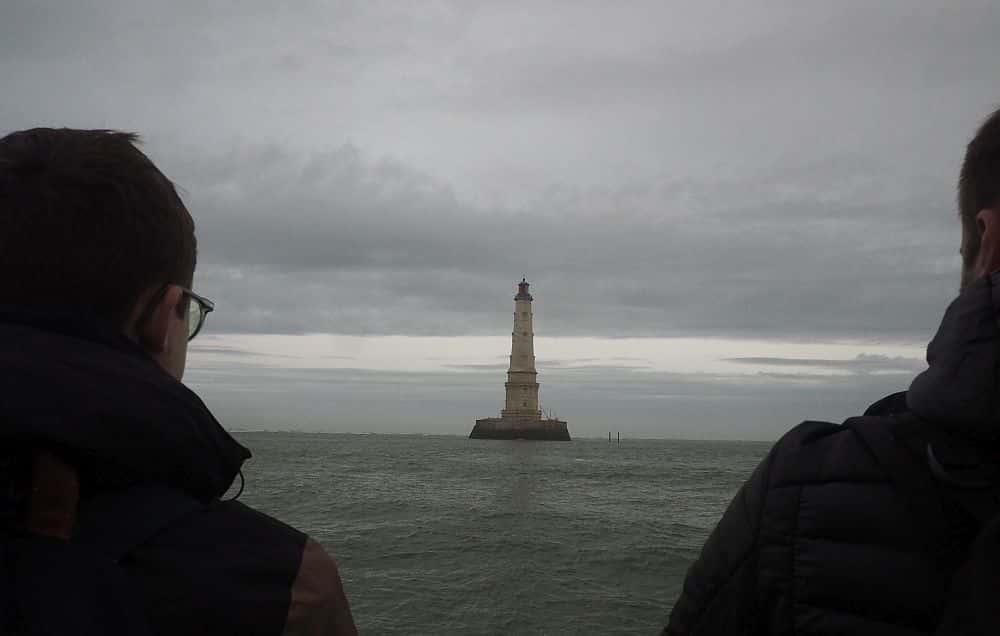
Anyway, alighting on the stairway once we finally reached it, we climbed a short way to the area inside the “crown.” The crown includes rooms for the lighthouse keepers, a public toilet, and the engineer’s house, which has been refurnished as it once was. In the center stands the lighthouse itself.
Inside the lighthouse
We could tour the lighthouse in a group with one of the lighthouse keepers, but I decided to go to the top before the crowd. In any case, the tour is in French, and my French isn’t great. There is a rack on the ground floor with leaflets about the lighthouse in a range of languages, so I used that.
The lower part of the lighthouse, dating to the 17th century, has a spiral staircase up one side. It takes you up to, first, the “King’s Apartment,” with its black and white marble floor and Corinthian columns. It’s so surprising to see such elegance inside a lighthouse!
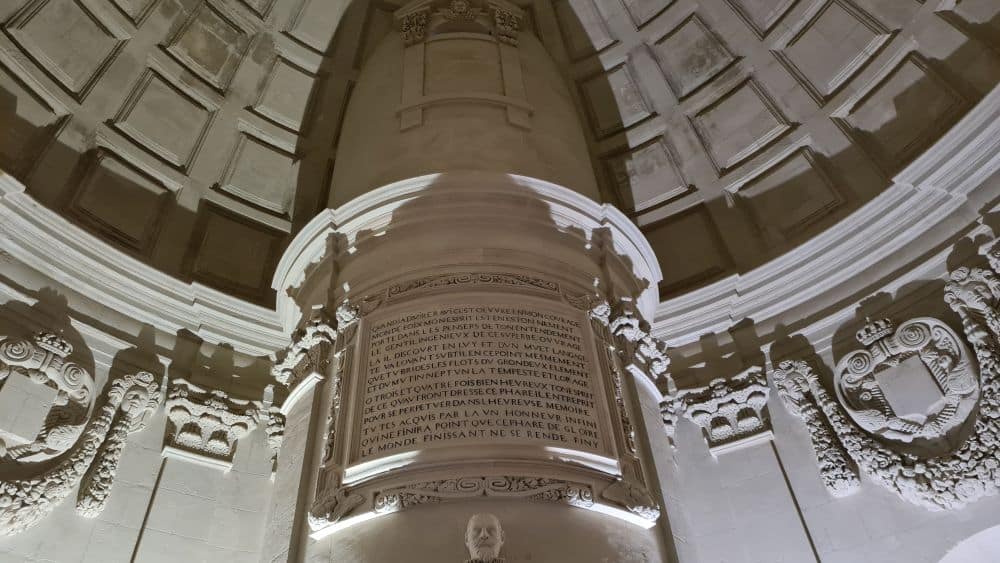
The 2nd floor, still in the 17th-century part of the building, is the Notre-Dame de Cordouan royal chapel. Henry IV, apparently, was eager to prove, after converting back and forth a number of times, that he was really and truly Catholic, not Protestant. This Catholic chapel, with its magnificent sculptures, was his way of demonstrating that. The domed ceiling surprised me here, but presumably this chapel was near the top of the original lighthouse.
Next I climbed the “new” part of the lighthouse, dating to the late 18th century. Here the stairway changes from a tight spiral like in a medieval castle, to a smooth curve around the outer walls. It’s just stunning. The two levels here are elegant but without the sculptural work of the lower levels. The 3rd floor is rather plain and empty, while the 4th is too, but originally it had an important function: it held the counterweight that rotated the lantern at the top. Until 1987, it had to be rewound every three hours. The lighthouse beam has been completely automated since 2006.
The 5th level is the lamp room. Besides the narrowing circle of the stairway, it only holds a display case showing examples of the sorts of lamps that used to light the beacon. Lastly is the 6th floor, where the “watch room” was where the lighthouse keepers kept watch.
Visitors can’t enter it, but, of course, at the top is the lantern itself. Instead, after climbing all 301 steps to just below the lantern, visitors can step out onto a balcony that circles the lighthouse.
The views are stunning. In one direction, on the side of the open sea, we could see huge waves crashing against rocks in the distance. In the other direction, the walkway was gradually appearing out of the water, as were lots of rocks, some of which we’d hit on the way in.
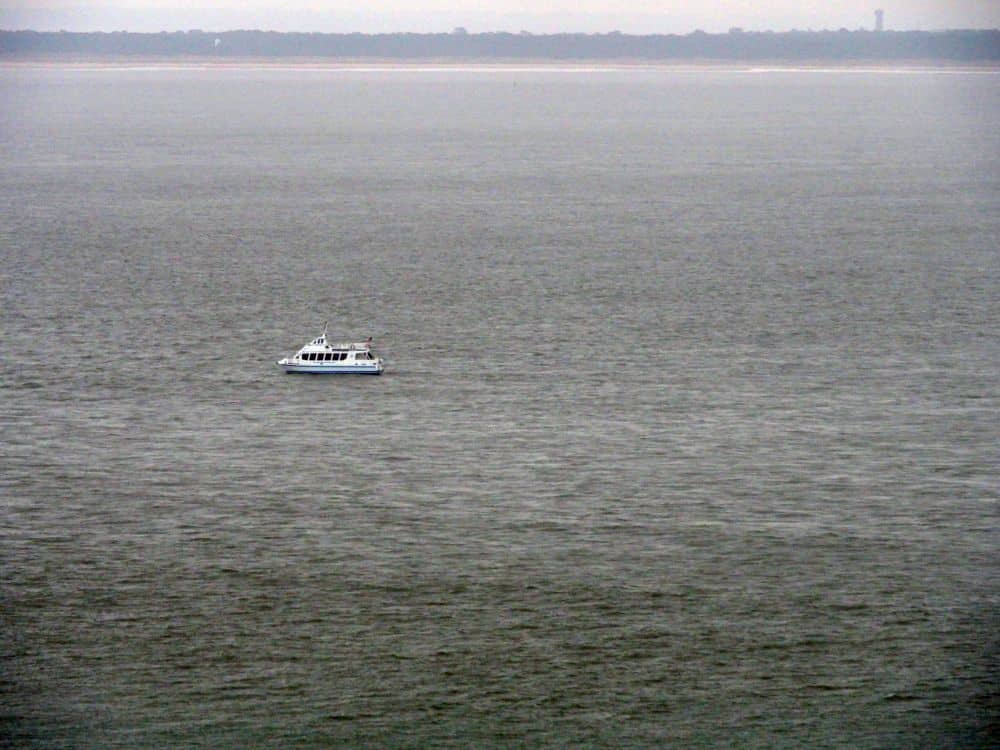
Returning from the lighthouse
To get back to the amphibious craft was harder than our arrival. It parked on the far end of a large sandbar that the receding water had exposed. All the passengers were required to walk to the end of the walkway, by this time no longer covered by the sea, but rather by a layer of small mussels and limpets. Then we walked over the sandbar, jumping puddles or splashing through them, to reach the craft.
On the other hand, the trip on the amphibious craft was easier this time. It switched smoothly from the wheels to floating – and the sea was distinctly calmer. We transferred onto the larger boat again, but it was a slower trip back to port. Apparently since the tide had gone out, we had to go extremely slowly as we neared Royan port because of how shallow the water had become.
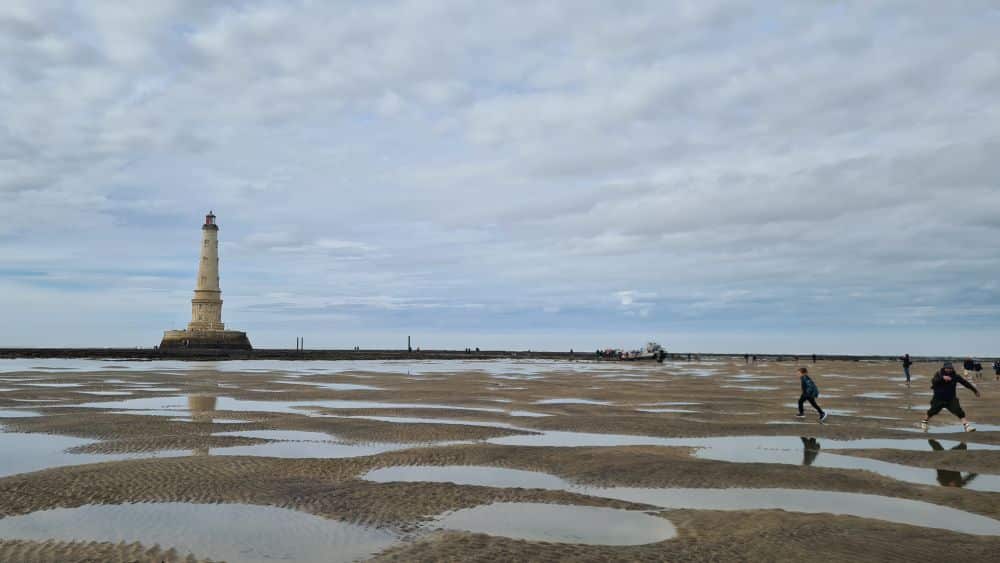
Is Cordouan Lighthouse worth visiting?
I certainly enjoyed it. It’s such an unexpected sight, and I always enjoy being on the sea. Certainly if you’re in the area and have most of a day available, it’s a fun and unusual things to do. It would not be worth visiting on a rainy day, however.
What sorts of travelers would like Cordouan?
Anyone with a modicum of interest in architectural history and/or lighthouses would enjoy this. The children on the trip seemed to like it too, though the sudden crunch of the amphibious craft scared some of them. They enjoyed climbing to the top, I think, and splashing across the sandbar, stopping to peer into tidal pools.
Tips for visiting Cordouan Lighthouse
This is most definitely not a trip for anyone with limited mobility. All of it requires walking: transferring between boats, climbing steps, and picking your way across a sandbar. A few older passengers were using walking sticks for balance and managed it fine.
It is also not a trip for anyone who gets seasick. There was one woman who spent most of the trip to the lighthouse bending over the rail.
We received an email the day before – we had already booked the trip – saying that we should bring along lunch. There’s plenty of time at the lighthouse to see it well and sit down and eat some sandwiches. There is no food or drink for sale, so bring your own. There’s also no drinking water, so especially on a hot day, make sure you bring enough along. Take all litter away with you.
What we were not told ahead of time was that we’d be splashing through water. If I’d known, I would have worn shorts, as many of the passengers did. But the boat company had a supply of water shoes, which they rented to us for a small sum. I was glad they did – my sneakers would have been thoroughly soaked otherwise, and I rolled up my jeans enough to not get them wet. So bring water shoes or wellies if you have them, and wear shorts. While you can slip off your shoes and walk barefoot on the sandbar, the barnacles and shellfish attached to the walkway and rocks would tear up your feet if you tried it there.
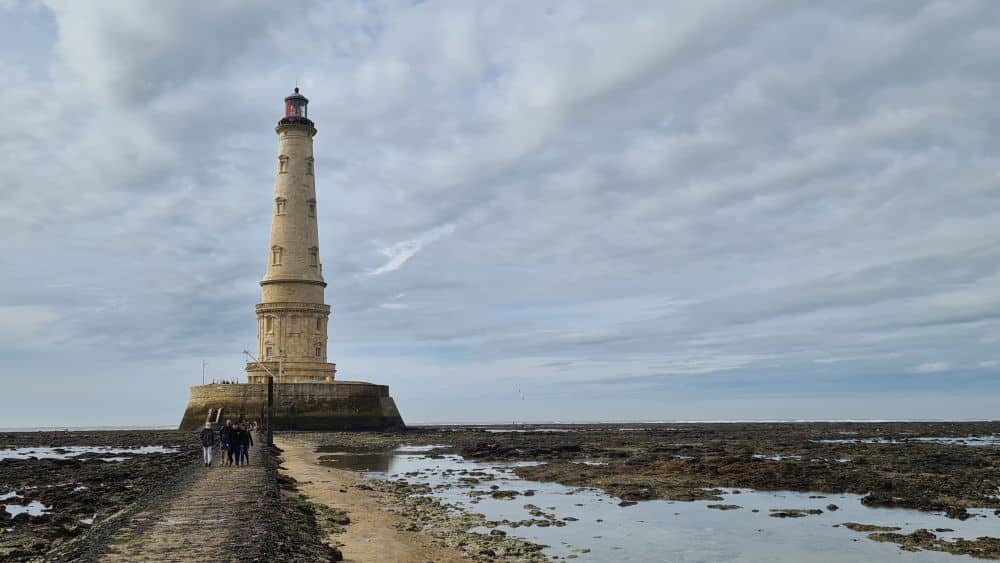
Book the tour (see links below) ahead of time, especially in the summer high season. Our boat was pretty full, and it was mid-October by then. The tours stop for the winter, when workers do whatever restoration work the lighthouse needs each year.
If you go during the summer, protect yourself from the sun with sun lotion. A hat might not be a good idea because of the wind. It can get chilly in the wind out there, so bring a windbreaker as well. Bring a raincoat if there’s any chance of rain.
To catch the boat in the morning, stay either in Le Verdon-sur-Mer or Royan. We drove up in the morning from Bordeaux.
If lighthouses are your particular obsession, don’t miss the Museum of Cordouan and Lighthouses & Beacons at the Pointe de Grave. Housed at the Grave Lighthouse at the tip of the peninsula dividing the sea from the Gironde estuary, it’s all about the history of lighthouses and beacons. You can climb to the top of Grave Lighthouse as well to enjoy the view.
Other UNESCO sites relatively nearby – and easier to get to – are Bordeaux itself, as well as the Jurisdiction of Saint-Emilion. Two of the fortresses included in the Fortifications of Vauban UNESCO site are pretty near too. One is to the north (St. Martin de Re) and one to the south (Blaye).
Where is Cordouan Lighthouse?
The lighthouse is on a rocky outcropping in the Atlantic Ocean outside the mouth of the Gironde River. You can reach it from either Royan to the east (Croisières La Sirène) or Le Verdon-sur-Mer on the peninsula (Vedettes La Bohême). To avoid disappointment, book ahead.
Royan is an hour and a half’s drive from Bordeaux and would take hours longer by public transportation. If you haven’t already done so, renting a car for the day might make it easier.
Le Verdon-sur-Mer is also about an hour and a half away by car, but is also easy to reach by train in under two hours. Take the SNCF train from Le Bouscat Sainte-Germaine station in Bordeaux to Le Verdon station – there are quite a few stops in between – and walk from there to the port.
If you are considering visiting the lighthouse with your own boat, read the instructions on the lighthouse’s official website before making a decision.
For more information about Cordouan Lighthouse, its opening hours and admission fees, see its official website.
Have you been to Cordouan Lighthouse? If so, do you have any additional information or advice about this UNESCO World Heritage site? Please add your comments below!

